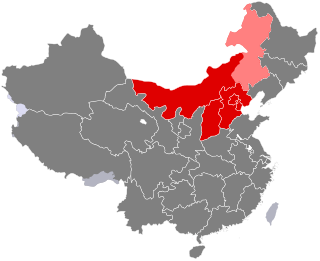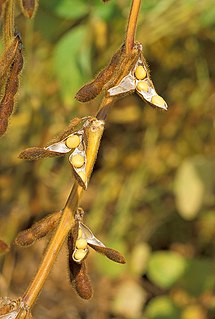
Chinese cuisine is an important part of Chinese culture, which includes cuisine originating from the diverse regions of China, as well as from Chinese people in other parts of the world. Because of the Chinese diaspora and historical power of the country, Chinese cuisine has influenced many other cuisines in Asia, with modifications made to cater to local palates. Chinese food staples such as rice, soy sauce, noodles, tea, and tofu, and utensils such as chopsticks and the wok, can now be found worldwide.

Soy sauce is a liquid condiment of Chinese origin, made from a fermented paste of soybeans, roasted grain, brine, and Aspergillus oryzae or Aspergillus sojae molds. Soy sauce in its current form was created about 2,200 years ago during the Western Han dynasty of ancient China, and spread throughout East and Southeast Asia where it is used in cooking and as a condiment.

The Forbidden City is a palace complex in central Beijing, China. The former Chinese imperial palace from the Ming dynasty to the end of the Qing dynasty, it now houses the Palace Museum. The Forbidden City served as the home of emperors and their households as well as the ceremonial and political center of Chinese government for almost 500 years.

Hebei is a province of China in the North China region. The modern province was established in 1911 as Zhili Province or Chihli Province. Its one-character abbreviation is "冀" (Jì), named after Ji Province, a Han dynasty province (zhou) that included what is now southern Hebei. The name Hebei literally means "north of the river", referring to its location entirely to the north of the Yellow River.

Zhao is a Chinese surname, ranking as the 7th most common surname in Mainland China and carried mainly by people of Mandarin-speaking regions. Zhao is the 1st surname in the famous Hundred Family Surnames – the traditional list of all Chinese surnames – because it was the emperor's surname of the Song Dynasty (960–1279) when the list was compiled.

Taiyuan is the capital and largest city of Shanxi province in China. It is one of the main manufacturing bases of China. Throughout its long history, Taiyuan was the capital or provisional capital of many dynasties in China, hence the name Lóngchéng.

The Ming tombs are a collection of mausoleums built by the emperors of the Ming dynasty of China. The first Ming emperor's tomb is located near his capital Nanjing. However, the majority of the Ming tombs are located in a cluster near Beijing and collectively known as the Thirteen Tombs of the Ming Dynasty. They are within the suburban Changping District of Beijing Municipality, 42 kilometres (26 mi) north-northwest of Beijing city center. The site, on the southern slope of Tianshou Mountain, was chosen based on the principles of feng shui by the third Ming emperor, the Yongle Emperor. After the construction of the Imperial Palace in 1420, the Yongle Emperor selected his burial site and created his own mausoleum. The subsequent emperors placed their tombs in the same valley.
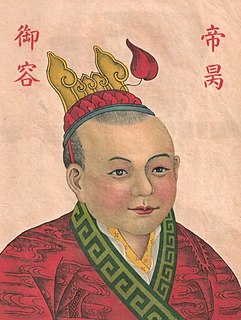
Zhao Bing, also known as Emperor Bing of Song or Bing, Emperor of Song (宋帝昺), was the 18th and last emperor of the Song dynasty in China. He was also the ninth and last emperor of the Southern Song dynasty. He reigned for about 313 days from 1278 to 1279 until his death.
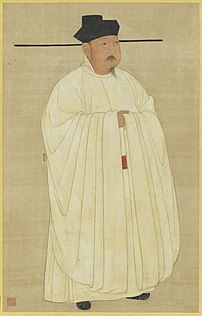
Zhao Jiong, known as Zhao Guangyi from 960 to 977 and Zhao Kuangyi before 960, also known by his temple name Taizong after his death, was the second emperor of the Song dynasty in China. He reigned from 976 to his death in 997. He was a younger brother of his predecessor Emperor Taizu, and the father of his successor Emperor Zhenzong.
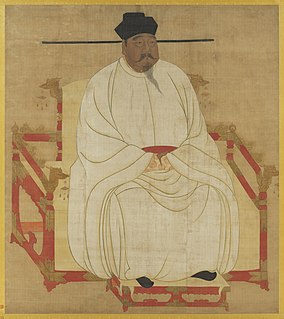
Emperor Taizu of Song personal name Zhao Kuangyin, courtesy name Yuanlang, was the founder and first emperor of the Song dynasty in China. He reigned from 960 until his death in 976. Formerly a distinguished military general of the Later Zhou dynasty, Emperor Taizu came to power after staging a coup d'état and forcing Emperor Gong, the last Later Zhou ruler, to abdicate the throne in his favour.

Emperor Renzong of Song, personal name Zhao Zhen, was the fourth emperor of the Song dynasty in China. He reigned for about 41 years from 1022 to his death in 1063, and was the longest reigning Song dynasty emperor. He was the sixth son of his predecessor, Emperor Zhenzong, and was succeeded by his cousin's son, Zhao Shu who took the throne as Emperor Yingzong because his own sons died prematurely. His original personal name was Zhao Shouyi but it was changed by imperial decree in 1018 to "Zhao Zhen", which means 'auspicious' in Chinese.

Gochujang or red chili paste is a savory, sweet, and spicy fermented condiment made from chili powder, glutinous rice, meju powder, yeotgireum, and salt. The sweetness comes from the starch of cooked glutinous rice, cultured with saccharifying enzymes during the fermentation process. Traditionally, it has been naturally fermented over years in jangdok (earthenware) on an elevated stone platform, called jangdokdae, in the backyard.

Zhajiangmian, or "noodles with soybean paste", is a Chinese dish consisting of thick wheat noodles topped with zhajiang sauce. Zhajiang sauce is normally made by simmering stir-fried ground pork or beef with salty fermented soybean paste. Zhajiang also means "fried sauce" in Chinese. Although the sauce itself is made by stir-frying, this homonym does not carry over into the Classical Chinese term.

Stinky tofu is a Chinese form of fermented tofu that has a strong odor. It is usually sold at night markets or roadside stands as a snack, or in lunch bars as a side dish, rather than in restaurants.

Douchi, or tochi is a type of fermented and salted black soybean. In English, it is known as fermented black soybeans, Chinese fermented black beans, salted black beans, salty black beans, or just black beans. They are a flavoring most popular in the cuisine of China, where they are most widely used for making black bean sauce dishes.

Emperor Gong of Song, personal name Zhao Xian, was the 16th emperor of the Song dynasty in China and the seventh emperor of the Southern Song Dynasty. The sixth son of his predecessor, Emperor Duzong, Zhao Xian came to the throne around the age of four, and reigned for less than two years before he was forced to abdicate in 1276. He was succeeded by his fifth brother, Zhao Shi, enthroned as Emperor Duanzong.
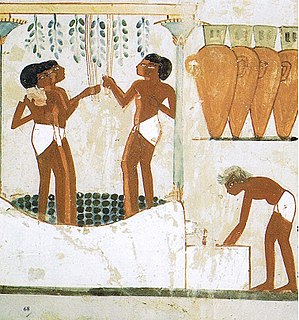
Fermentation in food processing is the process of converting carbohydrates to alcohol or organic acids using microorganisms—yeasts or bacteria—under anaerobic conditions. Fermentation usually implies that the action of microorganisms is desired. The science of fermentation is known as zymology or zymurgy.
The city of Beijing has a long and rich history that dates back over 3,000 years. Prior to the unification of China by the First Emperor in 221 BC, Beijing had been for centuries the capital of the ancient states of Ji and Yan. During the first millennia of imperial rule, Beijing was a provincial city in northern China. Its stature grew in the 10th to the 13th centuries when the nomadic Khitan and forest-dwelling Jurchen peoples from beyond the Great Wall expanded southward and made the city a capital of their dynasties, the Liao and Jin. When Kublai Khan made Dadu the capital of the Mongol-led Yuan dynasty (1279–1368), all of China was ruled from Beijing for the first time. From 1279 onward, with the exception of two interludes from 1368 to 1420 and 1928 to 1949, Beijing would remain as China's capital, serving as the seat of power for the Ming dynasty (1421–1644), the Manchu-led Qing dynasty (1644–1912), the early Republic of China (1912–1928) and now the People's Republic of China (1949–present).

Yellow soybean paste is a fermented paste made from yellow soybeans, salt, and water. Yellow soybean paste is produced in China and is used primarily in Beijing cuisine and other cuisines of northern China.

Paomo is a specialty of Shaanxi cuisine and is a typical food eaten in the city of Xi'an. It is a hot stew of chopped-up steamed leavened bread, cooked in lamb broth and served with lamb meat, sometimes substituted with beef.





